Related Research Articles

Aedes albopictus, from the mosquito (Culicidae) family, also known as (Asian) tiger mosquito or forest mosquito, is a mosquito native to the tropical and subtropical areas of Southeast Asia. In the past few decades, however, this species has spread to many countries through the transport of goods and international travel. It is characterized by the white bands on its legs and body.
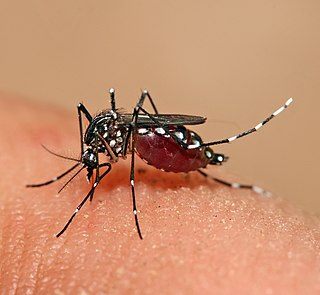
Aedes is a genus of mosquitoes originally found in tropical and subtropical zones, but now found on all continents except Antarctica. Some species have been spread by human activity: Aedes albopictus, a particularly invasive species, was recently spread to the New World, including the United States, by the used-tire trade.

Chikungunya is an infection caused by the Chikungunya virus (CHIKV). Symptoms include fever and joint pains. These typically occur two to twelve days after exposure. Other symptoms may include headache, muscle pain, joint swelling, and a rash. Symptoms usually improve within a week; however, occasionally the joint pain may last for months or years. The risk of death is around 1 in 1,000. The very young, old, and those with other health problems are at risk of more severe disease.

Arbovirus is an informal name used to refer to any viruses that are transmitted by arthropod vectors. The word arbovirus is an acronym. The word tibovirus is sometimes used to more specifically describe viruses transmitted by ticks, a superorder within the arthropods. Arboviruses can affect both animals and plants. In humans, symptoms of arbovirus infection generally occur 3–15 days after exposure to the virus and last three or four days. The most common clinical features of infection are fever, headache, and malaise, but encephalitis and viral hemorrhagic fever may also occur.

Vector control is any method to limit or eradicate the mammals, birds, insects or other arthropods which transmit disease pathogens. The most frequent type of vector control is mosquito control using a variety of strategies. Several of the "neglected tropical diseases" are spread by such vectors.

Aedes aegypti, the yellow fever mosquito, is a mosquito that can spread dengue fever, chikungunya, Zika fever, Mayaro and yellow fever viruses, and other disease agents. The mosquito can be recognized by white markings on its legs and a marking in the form of a lyre on the upper surface of its thorax. This mosquito originated in Africa, but is now found in tropical, subtropical and temperate regions throughout the world.
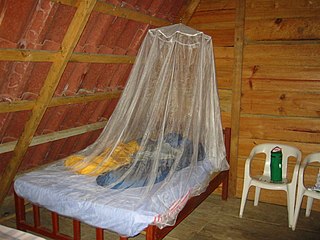
A mosquito net is a type of meshed curtain that is circumferentially draped over a bed or a sleeping area, to offer the sleeper barrier protection against bites and stings from mosquitos, flies, and other pest insects, and thus against the diseases they may carry. Examples of such preventable insect-borne diseases include malaria, dengue fever, yellow fever, zika virus and various forms of encephalitis, including the West Nile virus.

Mosquito control manages the population of mosquitoes to reduce their damage to human health, economies, and enjoyment. Mosquito control is a vital public-health practice throughout the world and especially in the tropics because mosquitoes spread many diseases, such as malaria and the Zika virus.

Zika fever, also known as Zika virus disease or simply Zika, is an infectious disease caused by the Zika virus. Most cases have no symptoms, but when present they are usually mild and can resemble dengue fever. Symptoms may include fever, red eyes, joint pain, headache, and a maculopapular rash. Symptoms generally last less than seven days. It has not caused any reported deaths during the initial infection. Mother-to-child transmission during pregnancy can cause microcephaly and other brain malformations in some babies. Infections in adults have been linked to Guillain–Barré syndrome (GBS).
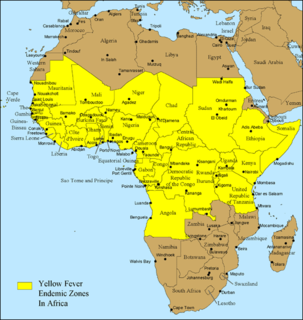
Mosquito-borne diseases or mosquito-borne illnesses are diseases caused by bacteria, viruses or parasites transmitted by mosquitoes. Nearly 700 million people get a mosquito-borne illness each year resulting in over one million deaths.

Zika virus (ZIKV) is a member of the virus family Flaviviridae. It is spread by daytime-active Aedes mosquitoes, such as A. aegypti and A. albopictus. Its name comes from the Ziika Forest of Uganda, where the virus was first isolated in 1947. Zika virus shares a genus with the dengue, yellow fever, Japanese encephalitis, and West Nile viruses. Since the 1950s, it has been known to occur within a narrow equatorial belt from Africa to Asia. From 2007 to 2016, the virus spread eastward, across the Pacific Ocean to the Americas, leading to the 2015–2016 Zika virus epidemic.
Rajpal Singh Yadav is an Indian scientist in the field of vector ecology and management at World Health Organization headquarters, Geneva, Switzerland. He has been working with various countries and international organizations to formulate and promote policies for public health pesticide management and vector control.
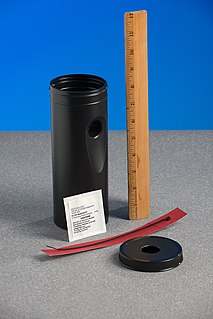
A lethal ovitrap is a device which attracts gravid female container-breeding mosquitoes and kills them. The traps halt the insect's life cycle by killing adult insects and stopping reproduction. The original use of ovitraps was to monitor the spread and density of Aedes and other container-breeding mosquito populations by collecting eggs which could be counted, or hatched to identify the types of insects. Since its conception, researchers found that adding lethal substances to the ovitraps could control the populations of these targeted species. These traps are called lethal ovitraps. They primarily target Aedes aegypti and Aedes albopictus mosquitoes, which are the main vectors of dengue fever, Zika virus, west Nile virus, yellow fever, and chikungunya.
Oxitec is a UK-based biotechnology company that develops genetically modified insects to assist in insect control. The genetically modified populations act as a "living insecticide". Destructive insects are controlled without the use of insecticides that may inflict unwanted side effects. The company claims that its method of population control is more effective than insecticides and more environmentally friendly.

In early 2015, a widespread epidemic of Zika fever, caused by the Zika virus in Brazil, spread to other parts of South and North America. It also affected several islands in the Pacific, and Southeast Asia. In January 2016, the World Health Organization (WHO) said the virus was likely to spread throughout most of the Americas by the end of the year. In November 2016, WHO announced the end of the Zika epidemic.
In October 2013, there was an outbreak of Zika fever in French Polynesia, the first outbreak of several Zika outbreaks across Oceania. With 8,723 cases reported, it was the largest outbreak of Zika fever before the outbreak in the Americas that began in April 2015. An earlier outbreak occurred on Yap Island in the Federated States of Micronesia in 2007, but it is thought that the 2013–2014 outbreak involved an independent introduction of the Zika virus from Southeast Asia. Investigators suggested that the outbreaks of mosquito-borne diseases in the Pacific from 2012 to 2014 were "the early stages of a wave that will continue for several years", particularly because of their vulnerability to infectious diseases stemming from isolation and immunologically naive populations.

Fredros Okumu is a Kenyan parasitologist and entomologist, who currently works as director of science at the Ifakara Health Institute (IHI) in Tanzania. His primary research interests concern the interactions between humans and mosquitoes.
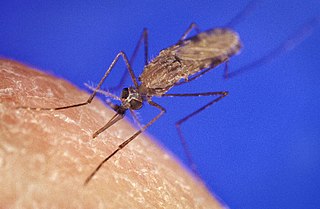
Airport malaria, sometimes known as baggage, luggage or suitcasemalaria, occurs when a malaria infected female Anopheles mosquito travels by aircraft from a country where malaria is common, arrives in a country where malaria is usually not found, and bites a person at or around the vicinity of the airport, or if the climate is suitable, travels in luggage and bites a person further away. The infected person usually presents with a fever in the absence of a recent travel history. There is often no suspicion of malaria, resulting in a delay in diagnosis and often death. Other causes of imported malaria need to be excluded first.

Mosquito Awareness Week or Mosquito Control Awareness Week is held every year in countries within the American continent, including the United States. In 2020, Mosquito Awareness Week is observed from June 22 to June 28. A separate Caribbean Mosquito Awareness Week (CARPA) is held earlier in the year, typically in April or May.
Lyda Elena Osorio Amaya is a Colombian physician, epidemiologist and infectious disease specialist. She is an associate professor at the Universidad del Valle, and a researcher at the Centro Internacional de Entrenamiento e Investigaciones Médicas (CIDEIM) in Cali, Valle del Cauca. Osorio's research has focused mainly on vector-borne diseases like malaria, leishmaniasis, Zika and dengue fever. She has also played a role in Colombia's response against COVID-19.
References
- ↑ "Erratum: Yellow fever, Asia and the East African slave trade". Trans R Soc Trop Med Hyg. 108: 519. 2014. doi: 10.1093/trstmh/tru081 .
- ↑ Gratz, NG; Steffen, R; Cocksedge, W (2000). "Why aircraft disinsection?". Bulletin of the World Health Organization. 78 (8): 995–1004. PMC 2560818 . PMID 10994283.
- ↑ Roth, A; Mercier, A; Lepers, C; Hoy, D; Duituturaga, S; Benyon, E; Guillaumot, L; Souares, Y (16 October 2014). "Concurrent outbreaks of dengue, chikungunya and Zika virus infections - an unprecedented epidemic wave of mosquito-borne viruses in the Pacific 2012-2014". Euro Surveillance. 19 (41): 20929. doi: 10.2807/1560-7917.ES2014.19.41.20929 . PMID 25345518.
- ↑ "Global Warming Plus Jet Travel Fuels 'Airport Malaria'". Wall Street Journal. Retrieved 16 February 2016.CS1 maint: discouraged parameter (link)
- ↑ "Strengthening health security by implementing the International Health Regulations (2005)". World Health Organization. Retrieved 16 February 2016.CS1 maint: discouraged parameter (link)
- ↑ "Aircraft disinsection". International travel and health. World Health Organization. Retrieved 16 February 2016.CS1 maint: discouraged parameter (link)
- ↑ "AIRCRAFT DISINFECTION INSECTICIDES" (PDF). World Health Organization. Retrieved 16 February 2016.CS1 maint: discouraged parameter (link)
- ↑ Hardiman, M; Wilder-Smith, A (2007). "The revised international health regulations and their relevance to travel medicine". Journal of Travel Medicine. 14 (3): 141–4. doi: 10.1111/j.1708-8305.2007.00117.x . PMID 17437468.CS1 maint: discouraged parameter (link)